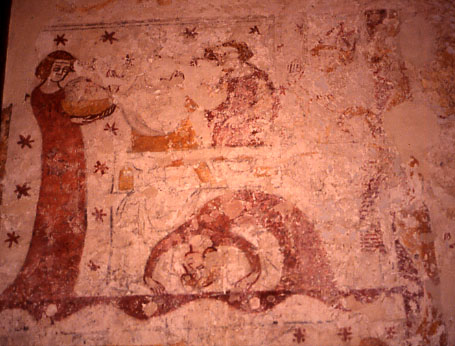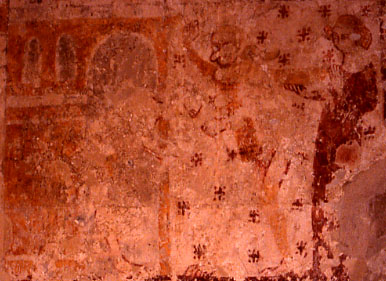Chalfont St Giles, Buckinghamshire (†Oxford) C.14
Herod’s Feast
Decollation of John the Baptist, with Salome

The grisly event is painted in two scenes, both featuring Salome. At the left, she stands at the extreme left, holding the head of John the Baptist on a charger, beside a table set with cups and dishes. Two or possibly three people are at the table, one, in the centre, is probably Herodias, Salome’s mother, another, on the right, seems to have a crown and is likely to be Herod. His hand is raised in horror.
The story unfolds in reverse from right to left. In front of the table Salome is shown dancing, bent backwards with head almost touching the ground and hands supporting her at either side. The pose is deliberately provocative, as in the 15th century painting of the subject at Heydon. There is a trace of another figure in a horizontally striped garment at the far right; this might be a servant holding the charger in readiness – there are also faint traces of something that might be a large circular dish.

Painted below and shown at the left is the granting of Salome’s request for the head of the Baptist At the left his own figure, bending in the arched doorway of what is presumably his prison, is very faint now, but his executioner, in the centre of the scene, is rather clearer. He has the grotesquely exaggerated facial features commonly found in paintings of the torture or execution of Christ and the saints, with a prominent nose and huge jutting chin. His right hand is raised for the death-stroke (virtually all trace of the sword has gone), and he might be grasping John by the hair with his left. Salome appears again, standing at the far right, holding the empty charger.
Salome was a byword for female lasciviousness in the Middle Ages¹ and her mother Herodias had become associated with witchcraft by the 15th century². Paintings of her dance in English churches are rare now, but all of those known to me (including the example at Pickering, now on the site) insist on its indecorous nature. These paintings, juxtaposed as they are with scenes from the Passion and from the Life of the Virgin, must have created a frisson of horror in the churchfolk of medieval Chalfont St Giles.
Other paintings at Chalfont St Giles include a Life and Miracles of the Virgin, and The Creation of the Animals/Fall & Expulsion from Eden, both now on the site. Others will be here in due course.
¹ Caesarius of Heisterbach, in a story about traffic in relics, specifically the arm of John the Baptist as “the price of fornication”, cites Salome – “a lascivious girl” – as an evil examplar; In Caesarius of Heisterbach, Distinctio VIII, Cap. liii [quoted here from J. Krochalis & E. Peters, The World of Piers Plowman, University of Pennysylvania Press, 1975, p.155]
² Herodias is named, along with “Diana, a goddess of the pagans”, in the Malleus Maleficarum as a leader of those “wicked women, perverted by Satan, [who] believe and profess [that they] ride in the night-time on certain beasts…over immense tracts of land, and have to obey her in all things as their Mistress, etc.” J. Sprenger & H. Kramer, Malleus Maleficarum, 1486, Chapter 111, (trs. M. Summers, Folio Society, London,1968.)